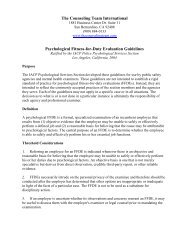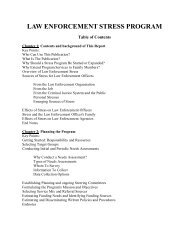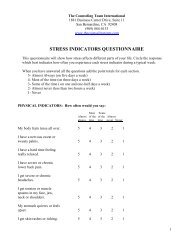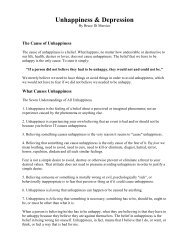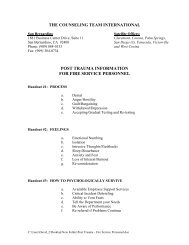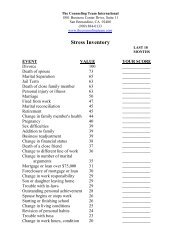<strong>The</strong> available empirical and anecdotal evidence convincingly documents that stress amongcorrectional officers is widespread and, in many cases, severe.[1] Furthermore, severalcircumstances may have created increased stress for correctional officers in recent years: Inmate crowding has increased in many correctional facilities. Furthermore, the ratio ofinmates to custody or security employees rose from 4.2 to 4.6 between 1990 and 1995.[2] Inmate assaults against correctional staff in State and Federal prisons have increased.Between 1990 and 1995, the number of attacks jumped by nearly one-third, from 10,731to 14,165.[3] During this same period, the number of correctional officers increased byonly 14 percent,[4] resulting in an overall increased risk of assault for each individualofficer at the end of this period. Assaults in jails appear to have declined between 1990 and 1996 from 3.2 per 100prisoners in 1990 to 2.4 in 1996, with a peak of 3.6 in 1992. However, in absolute terms,there was an average of 42 assaults by prisoners on jail staff per jail system in 1996,including an average of 206 assaults in each of the Nation's 17 largest jail systems,representing on average of 4 assaults per week.[5] Many offenders serving increasingly longer sentences do not fear punishment or respectthe authority of correctional officers.[6] According to one superintendent, "Inmates todayaren't afraid to assault staff; they don't care if they get put in segregation." <strong>The</strong>re are more gangs-and more dangerous gangs-in prison.[7]What Causes Stress for Correctional Officers?Many years ago a researcher observed, "any organization or social structure which consists ofone group of people kept inside who do not want to be there and the other group who are there tomake sure they stay in will be an organization under stress."[8] More recently, A.T. Wall,director of the Rhode Island Department of Corrections, confirmed this observation based onfirsthand experience: "You have a captive population that doesn't want to be here and wants to beas comfortable as possible for as long as they have to be incarcerated. And correctional officersstand in the way of those desires, so there's built-in tension and manipulation."Beyond this global source of stress, it is possible to distinguish among stresses caused by thecorrectional organization, those created by correctional work itself, and those brought on byfactors external to the facility.Organizational sources of stressMany individuals interviewed for this report suggested that organization-related conditionscreate stress for many officers, in particular, understaffing, overtime, shift work, and supervisordemands.Understaffing
In many prisons and jails, there are too few officers available to staff authorized posts as a resultof unattractive salaries, high turnover, and excessive use of sick time and disability leave.Understaffing can create several different kinds of stress:Lack of time to complete required tasks, such as head counts, searches, and paperwork, atall or in a conscientious manner.Occasionally working at breakneck speed to complete the required work, as well asaddressing unplanned inmate needs and requests.Apprehension when there are too few officers available as backup should inmate violenceoccur.Inability to get time off for special occasions or family crises.OvertimeStaff shortages create the need for extensive overtime among remaining staff. According to anintake administrator for a State department of corrections, "At least 100 officers have told methey don't answer their telephones because it might be the institution calling for overtime." Someofficers get a second, unlisted telephone number, which they keep secret from the department.One facility allows officers to refuse overtime assignments only once a year; a second refusalresults in a warning; a third, in a 1-day suspension; and a fourth, in possible termination. Someofficers welcome overtime because of the extra money they can earn. As one officer said,"Overtime is great--I worked three OTs a week for 18 months." However, she quickly added,"But I got burned out, and my supervisors didn't even acknowledge my contribution."Rotating shift workCorrectional officers consistently report that rotating shifts create havoc with family life andreduce officers' ability to perform their work conscientiously because of fatigue and irritability."You can tell when shift work is getting to officers," a lieutenant said. "<strong>The</strong>ir work gets sloppy,their searches become careless, their units are filthy, and they stop following the rules."Supervisor demandsSeveral correctional officers reported that supervisors are a source of stress because, as oneofficer said, "<strong>The</strong>y are always on you to do the job right, but you can't do it right [because ofstaff shortages]. <strong>The</strong>re is supposed to be one officer per tier here, but now they've collapsed theposts, and there is one officer for every two tiers. So there just isn't enough time for me to getinmates awakened, showered, and fed; keep my log books up to date; do my checks; and makesure the catwalks have all been cleaned and disinfected."Other stress sources
- Page 1 and 2: ISSUES AND PRACTICESAuthor: Peter F
- Page 3 and 4: The various program options present
- Page 5 and 6: Program overviewCollaboration with
- Page 7 and 8: An unproven interventionPotential b
- Page 9 and 10: Executive SummaryAddressing Correct
- Page 11 and 12: One officer said, "The public hasn'
- Page 13 and 14: Correctional officer union official
- Page 15 and 16: Doing the job carefully in records
- Page 17 and 18: 2. "Commissioner Locks Down Prison
- Page 19: Chapter 2The Extent and Sources of
- Page 23 and 24: promising not to create trouble or
- Page 25 and 26: 6. Martinez, A.R., "Corrections Off
- Page 27 and 28: How to Cope with Job Burnout, New Y
- Page 29 and 30: e. Kamerman, J., "Corrections Offic
- Page 31 and 32: Family Service Society serves only
- Page 33 and 34: Society also provides inservice tra
- Page 35 and 36: Family Service Society refers emplo
- Page 37 and 38: Staff more likely to be viewed by o
- Page 39 and 40: Unit team responsibilitiesTypically
- Page 41 and 42: officers were involved. We took tur
- Page 43 and 44: In 1998, the New York State Departm
- Page 45 and 46: An officer and a lieutenant, both o
- Page 47 and 48: Bruce W. BakerAssistant Commissione
- Page 49 and 50: Technical assistance and training t
- Page 51 and 52: Chapter 4Program Staffing, Training
- Page 53 and 54: Most new clinicians fill in their g
- Page 55 and 56: wanted the best. In addition, the p
- Page 57 and 58: Each New York State Department of C
- Page 59 and 60: DOCs and sheriff's departments can
- Page 61 and 62: Counseling Team] that it's OK to sa
- Page 63 and 64: Outreach to line officers is essent
- Page 65 and 66: The program permits team members to
- Page 67 and 68: Exhibit 5-1 Union MemorandumAccordi
- Page 69 and 70: The Counseling Team and Rhode Islan
- Page 71 and 72:
grant ended in December 1998, Sheri
- Page 73 and 74:
Snacks, lunch, and child care were
- Page 75 and 76:
As with wardens, seeing is believin
- Page 77 and 78:
1. For further information about th
- Page 79 and 80:
department. However, the rules of c
- Page 81 and 82:
John Near, the South Carolina DOC's
- Page 83 and 84:
While there is no evidence that deb
- Page 85 and 86:
Organizational changes departments
- Page 87 and 88:
* Appelbaum, P.S., and T.G. Gutheil
- Page 89 and 90:
Telephone hotline, providing 24-hou
- Page 91 and 92:
Chapter 7Evaluation, Funding, and T
- Page 93 and 94:
the regional teams and facility adm
- Page 95 and 96:
A psychologist hired under the gran
- Page 97 and 98:
Assuming four of the five unit memb
- Page 99 and 100:
consultation.
- Page 101 and 102:
the survey that will follow." The r




